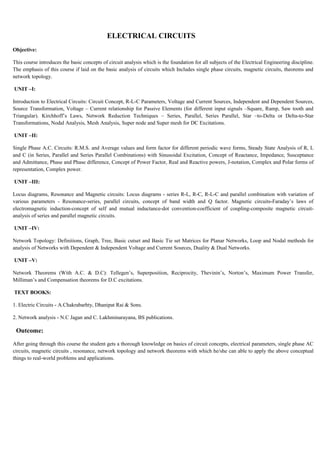Electrical circuits
- 1. ELECTRICAL CIRCUITS Objective: This course introduces the basic concepts of circuit analysis which is the foundation for all subjects of the Electrical Engineering discipline. The emphasis of this course if laid on the basic analysis of circuits which Includes single phase circuits, magnetic circuits, theorems and network topology. UNIT –I: Introduction to Electrical Circuits: Circuit Concept, R-L-C Parameters, Voltage and Current Sources, Independent and Dependent Sources, Source Transformation, Voltage – Current relationship for Passive Elements (for different input signals –Square, Ramp, Saw tooth and Triangular). Kirchhoff’s Laws, Network Reduction Techniques – Series, Parallel, Series Parallel, Star –to-Delta or Delta-to-Star Transformations, Nodal Analysis, Mesh Analysis, Super node and Super mesh for DC Excitations. UNIT –II: Single Phase A.C. Circuits: R.M.S. and Average values and form factor for different periodic wave forms, Steady State Analysis of R, L and C (in Series, Parallel and Series Parallel Combinations) with Sinusoidal Excitation, Concept of Reactance, Impedance, Susceptance and Admittance, Phase and Phase difference, Concept of Power Factor, Real and Reactive powers, J-notation, Complex and Polar forms of representation, Complex power. UNIT –III: Locus diagrams, Resonance and Magnetic circuits: Locus diagrams - series R-L, R-C, R-L-C and parallel combination with variation of various parameters - Resonance-series, parallel circuits, concept of band width and Q factor. Magnetic circuits-Faraday’s laws of electromagnetic induction-concept of self and mutual inductance-dot convention-coefficient of coupling-composite magnetic circuit- analysis of series and parallel magnetic circuits. UNIT –IV: Network Topology: Definitions, Graph, Tree, Basic cutset and Basic Tie set Matrices for Planar Networks, Loop and Nodal methods for analysis of Networks with Dependent & Independent Voltage and Current Sources, Duality & Dual Networks. UNIT –V: Network Theorems (With A.C. & D.C): Tellegen’s, Superposition, Reciprocity, Thevinin’s, Norton’s, Maximum Power Transfer, Milliman’s and Compensation theorems for D.C excitations. TEXT BOOKS: 1. Electric Circuits - A.Chakrabarhty, Dhanipat Rai & Sons. 2. Network analysis - N.C Jagan and C. Lakhminarayana, BS publications. Outcome: After going through this course the student gets a thorough knowledge on basics of circuit concepts, electrical parameters, single phase AC circuits, magnetic circuits , resonance, network topology and network theorems with which he/she can able to apply the above conceptual things to real-world problems and applications.

